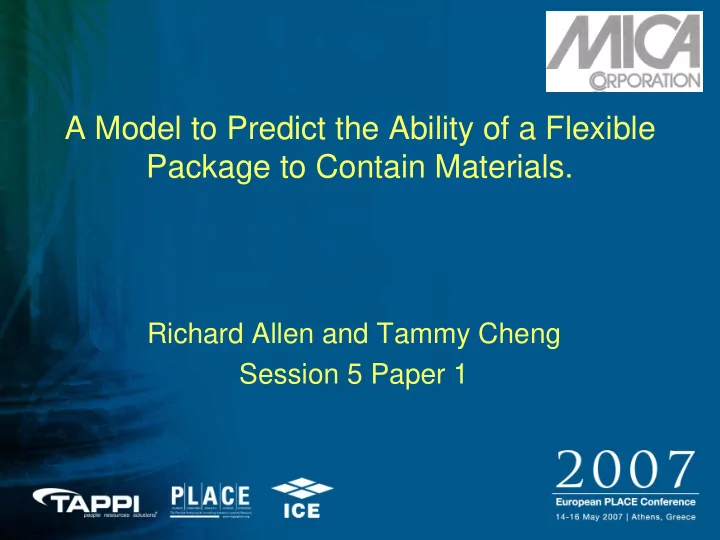

A Model to Predict the Ability of a Flexible Package to Contain Materials. Richard Allen and Tammy Cheng Session 5 Paper 1 Paper 9.3, Allen, Cheng
Containment Testing of Flexible Packaging • Cumbersome and time consuming. • One test for each material. • Subjective. Is there a better way? Paper 9.3, Allen, Cheng
Definitions • Material = The item “contained” in the package. • Containment = Ability of package to hold a material for a specified time without failure. • Sealant = The heat seal layer. • Adhesive = Adhesive or Primer • Substrate = Supporting film, in this case aluminum. Paper 9.3, Allen, Cheng
The Concept • To be destructive, a material must first pass through sealant layer (permeation) AND must degrade the bond of sealant to substrate. The probability of package failure = Permeability X Adhesive bond disruption. Paper 9.3, Allen, Cheng
Permeation of contained material through sealant. Low High Bond disruption by contained material. Low Should be contained: Both May be contained: Sealant adhesive and sealant unaffected. may swell. May be contained for a time: Difficult to Contain: Both sealant Until the material diffuses through and adhesive may be affected. sealant and disrupts bond. High Paper 9.3, Allen, Cheng
Axis 1: Permeation of contained material through sealant. Paper 9.3, Allen, Cheng
Permeation of Materials Through Polymers. P = D x S P = Permeation D = Diffusivity ~ How fast the material passes through the sealant. S = Solubility ~ How much material the sealant will hold. Paper 9.3, Allen, Cheng
Primary Factors that Affect the Permeation of a Material Through a Sealant. • Sealant composition, crystallinity and Tg. • Material composition and molecular weight. • Temperature. Paper 9.3, Allen, Cheng
Diffusion Affected by Molecular Weight and Temperature. Time for 1/2 of Material in 25 micron LDPE to Migrate . 1000000 100 years 100000 10 Years 10000 Time (hrs.) 1 year 1000 1 week 100 20C (68F) 50C (122F) 10 1 0 500 1000 1500 2000 2500 3000 3500 0.1 0.01 0 . 001 0.0001 Molecular Weight of Material (daltons) Paper 9.3, Allen, Cheng
Swelling of Sealants in Various Materials (%) Contained LDPE EAA Ionomer PP Material copolymer Water 0 -0.9 -3.1 0 IPA 2.1 19.1 13.0 2.9 Vinegar 0 1.0 0.7 0 Tabasco 1.0 0.7 2.0 0.6 Mineral oil 8.4 5.0 8.3 3.8 Motor oil 10.5 6.5 10.9 3.0 Skin-So-Soft 15.3 14.7 21.0 9.5 Dioctyl 4.8 4.8 4.8 4.8 sebecate Paper 9.3, Allen, Cheng
Observations. • Polarity mis-match is important: – Polar water does not swell these relatively non-polar sealants – Slightly polar alcohol and vinegar swell non-polar PE or PP little, but swell slightly polar EAA and ionomer. – Non-polar oils swell all sealants but slightly polar EAA better than non-polar PE. • Crystallinity is important: – PP is the most crystalline sealant tested and swells the least in just about all materials. Paper 9.3, Allen, Cheng
Conclusion About Permeation • Low molecular weight liquids can be difficult to contain because they diffuse the fast. • Sealant selection can be important. – Diffusion through PP is 44 X slower than PE. – A polarity mismatch between sealant and contained material may help. Paper 9.3, Allen, Cheng
Axis 2: Bond Disruption by Contained Material. Paper 9.3, Allen, Cheng
Factors that Disrupt Bonds of Adhesives. • Chemical: – Competition for adhesive bonding sites by contained material. – Chemical reaction with adhesive • Physical: – Solubility of material in adhesive. Paper 9.3, Allen, Cheng
Bond Disruption by Competition for Bonding Sites Polyethylene EAA Primer + HO 2 CCH3 C C O O O O Aluminum Surface CO 2 H CH 3 CH 3 HO 2 C C C O O O O Paper 9.3, Allen, Cheng
Bond Disruption by Chemical Reaction with Adhesive Polyester polyurethane CO 2 -R-O 2 C + R’OH Alcohol Lower MW polyurethane CO 2 R’ + H-O-R-O 2 C Paper 9.3, Allen, Cheng
Physical Bond Disruption by Plasticization of the Adhesive by the Contained Material. Modulus or Strength Failure under stress. % Material (solvent) in Adhesive Small amounts of solvent can significantly weaken bond Paper 9.3, Allen, Cheng
Average Peel Force after Immersion of (Al/primer/PE) in Material for 4 days. Primer A Primer B (g/25mm) (g/25mm) None Film tear at 835 Film tear at 629 Water 331 Film tear at 548 Water/Ethanol 62 404 1:1 Soybean oil Film tear t1106 Film tear at 593 White Vinegar 18 240 Skin-So-Soft Film tear at 739 650/353 Hot sauce 180 362 Paper 9.3, Allen, Cheng
Results For (Al/primer/PE) Permeation of contained material through sealant. Low High Bond disruption by contained material. Should be contained: May be contained: Low e Dry foods r e Oils with no aggressive additives H (e.g.. Mineral oil, soybean oil) Dioctyl succinate d e d e e N Water s t n a l a Alcohol Oils with semi-aggressive additives e S (e.g.. Hand Lotions.) e l b a May be contained for a time: Difficult to Contain: e m r e P Alcohol / Water t s mixture. Wipes. a e L Oils with aggressive additives (e.g.. motor oil) Most Robust Adhesives Needed Here Acidic: High vinegar and hot sauce Paper 9.3, Allen, Cheng
Conclusions • The probability of package failure = permeability X adhesive bond disruption. • Proper selection of sealant or adhesive can maximize the integrity of the package over time. Paper 9.3, Allen, Cheng
Recommend
More recommend